CRITTERS
AT BRAZOS BEND STATE PARK--SNAKES non-venomous 3
This
page was born 10/23/2006. Rickubis designed it. (such as it
is.) Last update: 04\13\2022
Images
and contents on this page copyright ©2002-2022 Richard
M. Dashnau
Snakes page 1 nonvenomous 2001 -2002 Snakes page 6 Rat Snakes 2002 - 2021
Snakes page 2 nonvenomous 2003 -2004 Snakes page 7 venomous 2002 -2021
Snakes page 4 nonvenomous 2006 -2021
Snakes page 5 nonvenomous 2022 -2023
----------------------------------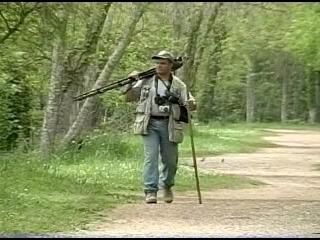
That's
me on a trail
(03/29/2004). As I get more pictures, these pages expand. I've gotten
enough
images of snakes to collect them here. For most of my identification,
I'm using "Texas Snakes-a field guide", by James R. Dixon and John E.
Werler (2000, 2005)
March 29, 2006 The
image below is from one of the photos I took with my digital still camera
at Brazos Bend State Park.
I was
by the 40-acre observation tower, and there was a
small group of people
there. I was talking about the animals
we could
see from there (nutria, etc.), when a man shouted "SNAKE!". ---------------------------------------------------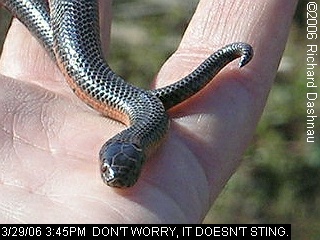
I turned
around, and a man sitting on the bench pointed at a snake slithering almost
between his feet. I ran over and picked it
up (it
was about 8 inches long), and discovered that it was a
Western Mud Snake (Farancia abacura reinwardti) ! So,
after I explained (I did this a number of times)
that
I ONLY picked up the snake so it wouldn't get stepped on, I talked about
it; and
about a hoop snake, and about "stingers"
on snake's
tails, and so on. About 5 or 10 minutes later, I heard another shout, of
"ANOTHER SNAKE!". I turned, and it was the same guy
who'd
seen the first one. He was still sitting on the end of the bench. And,
ANOTHER young Mud Snake was crawling right towards him!
This
time, it got to the grass under the bench before I
could catch it, and
I lost that one. That was pretty funny.
That
guy wouldn't sit on the bench any more, even though he stayed around for
a while. When it finally got quiet, I let the snake go.
Before
I did, I took a few pictures, and a few short video clips. You can see
one clip here (wmv 2126kb).
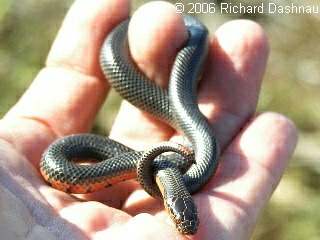 -
-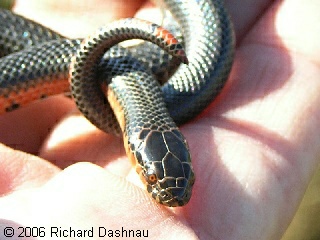 -
-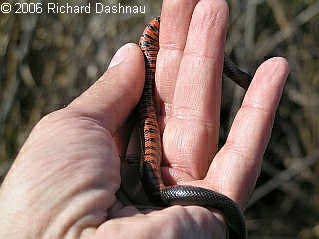 -
-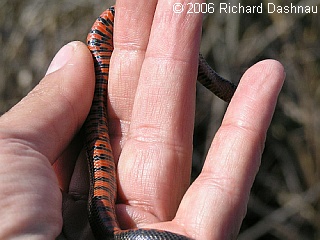 -
-
---
SNAKE
IN MY HAND
SHARP TAIL OVER HEAD
BRILLIANT UNDERSIDE
UNDERSIDE, CLOSER
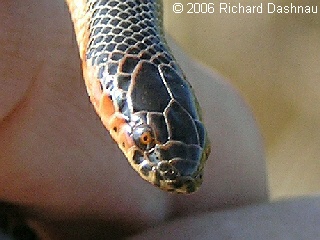 -
-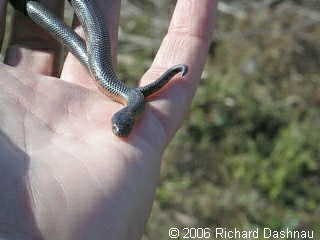 --
--
CLOSEUP
OF THE HEAD
FRAME FROM THE VIDEO
CLIP (WMV 2126KB)
A lot
of people (including me) have been seeing the Bitterns eating small snakes
lately. I couldn't tell what kind of snakes I saw
then.
The Mud Snake is easily identifiable by the glossy, sometimes iridescent
dark back and brilliant red with black underside.
Mudsnakes
have small eyes, with round pupils, and a head that
is no wider than its
neck. It also has a sharp spine at the end of a short
tail. This spine looks like a stinger, but is harmless to humans. Here's
some more information about this snake, from my
copy of Texas Snakes, by
Werler and Dixon.
1 species
of Mud Snake is listed, the Western Mud Snake (Farancia abacura reinwardti).
The adults are generally 3 or 4 feet long. According
to
the book, this is one of the most docile snakes likely to be encountered
in the field. The favored food of the
Mud
Snake is said to be amphiumas or sirens.
Both
of these are long amphibians
that resemble eels. Mud Snakes are also known
to eat salamanders, tadpoles, and fish. While feeding,
the Mudsnake has been observed to be a ferocious antagonist when attacking
prey such
as an amphiuma which can
violently
defend itself. Now here's something especially interesting. Mud Snakes
are one of the few snakes in the entire world
that
actually remains with their eggs
throughout incubation.
Some
older readers may recall a legendary critter called a "hoop snake". I used
to see mention of this from time to time when
I was
younger. In the Werler and Dixon book,
the critter is said to have been
able to grab its tail in its mouth, make its body into
a hoop,
and roll downhill after a victim. When it got close enough, it would then--on
the fly--straighten its body into
a spear shape
and
impale the victim with the point on its tail. Within seconds the victim
would be a goner. Pretty amazing, eh? Remember, this
was
all folklore.
Anyway,
THIS snake, the Mud Snake, is generally believed to be the "basis" for
the "hoop snake". If captured, the Mud Snake will
sometimes
poke or probe with the point on its tail; and this
probing could cause
a predator to drop it in surprise. The Mud Snake will
sometimes
suddenly curl its tail or portions of its body, which shows the brighter
underside. This can also be a method
of intimidation.
This
flipping over is sometimes accompanied by the tail being raised and curled.
Finally, the tail is said to be used to help control
prey
that the snake has caught.
January
02, 2005I
had some spare time in the VC/NC at Brazos Bend State Park, so I decided
to take some pictures of the beautiful juvenile Eastern Hognose snake that
is visiting us there.
I got most of the following information from
the book: Texas Snakes, by John E. Werler and James R. Dixon. The Eastern
Hognose Snake (heterodon platirhinos) is a heavy-bodied snake that
grows from 20 to 33.5 inches. It comes in a wide array of colors. At first
glance it may seem to resemble a rattlesnake or a cottonmouth. Unlike these
snakes, it is generally considered harmless.
It can easily be distinguished
from these snakes by its upturned nose and round pupils (the pit vipers
have elliptical, or slit pupils). Although it is generally harmless, its
unique defensive behavior
probably provokes a number of people to kill
it out of hand. The Hognose snake prefers terrain with loose soil and ground
cover. It likes to burrow, using the upturned snout like a plow to dig.
It
also prefers moist areas, since its main food is amphibians. These snakes
prefer toads, but if frogs are more plentiful, it will eat
them.
Hognosed snakes have a pair of elongated teeth set back
from the front
of the upper jaw (Heterodon means "different tooth"). Unlike fangs of venemous
snakes, these teeth are thought to be used to hold their slippery amphibian
prey. Also, while eating
toads, these teeth may also be used to puncture
the toads so they can be swallowed. Toad take in air and expand when they
are threatened. This can make them seem larger and more
menacing, but it
also makes them hard to swallow whole. Toads also have poison glands on
their skin, and almost any other animal that attempts to eat them will
get very sick--and possibly even
die--from reactions to the toad's secretions.
According to Werler's Book, Hognosed snakes have an enlarged adrenal gland--larger
than any other Texas snake--which may have something to
do with their resistance
to the toad toxins.
Other
sources mention that Hognosed snakes also have a secretion in their mouths
that is thought to neutralize the effects of toad venom. All of this
sounds pretty harmless, right? It is.
It's
the Hognose Snakes defensive show that might cause humans to kill it.
When a Hognose snake is threatened, it will first lie still, like many
other animals. If that doesn't work, it may try to crawl
away. If these
first two ploys don't work, then the show starts. First, the snake can
flatten its head and the neck area behind it, so that from above
or the front, this area can
appear
almost 3 times
bigger. At the same time, it will take deep breaths which
cause its body to expand and contract, and it will also hiss loudly. How
do you think a typical homeowner would react to this; especially
if
there are gardening tools close by? If this acting hasn't driven off
an attacker, then the snake begins striking repeatedly. However, these
strikes are almost always done WITH THE MOUTH
CLOSED, and no contact is
made. It's all a bluff! Can you imagine the snake surviving an encounter
with most humans after all of this? Finally, if its antagonist
is still around, and perhaps touches
the snake, the snake begins to twist
and contort. It acts as if it's been mortally wounded. During this time,
the snake will void material from its bowels, and if it's eaten recently,
it will regurgitate. A
strong musk is also expelled from glands near
the tail. After a while, the snake will stop moving, with its belly up.
It will play dead, with mouth slack, and even with its tongue lolling out.
The snake
will lie there until the antagonist loses interest or leaves.
Then, the hognose snake turns back onto its stomach and crawls off.
I took a few pictures of the young "red" Hognose snake, (see CUTE
LITTLE
ONE and ROUND PUPILS, below) and while I was taking the pictures, the camera
flash might have annoyed it. It widened its head a bit.
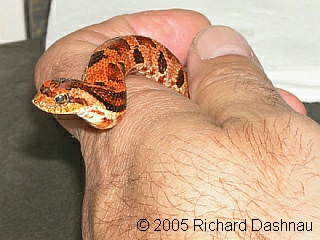 -
-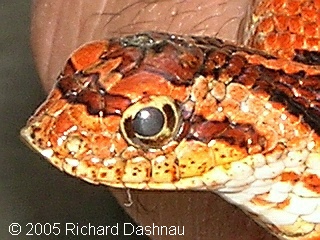 -
-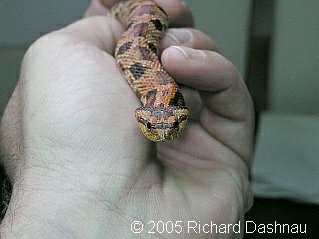
CUTE LITTLE ONE
ROUND PUPILS
SLIGHTLY ANNOYED
-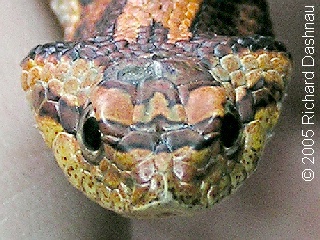 -
-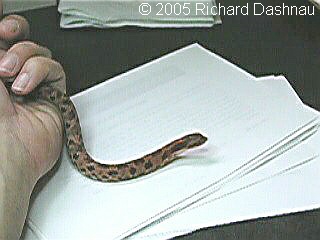
COOL ARROWHEAD
VIDEO
CLIP (435KB)
You
can see the slightly widened head. (see SLIGHTLY ANNOYED and COOL ARROWHEAD,
above). With the shades of orange, and the "triangular-shaped" head
shown here, I can imagine this
snake being mistaken for a copperhead and
killed--even though it doesn't really resemble a copperhead. Note the interesting
dark band that goes from one "cheek", across the eyes, and down the
other
cheek.The snake only showed this head display for a few brief intervals.
I finally took a short video
clip of the young snake, just to show how it moved.
We also
have an adult Hognose snake,
and I thought it might be interesting to contrast
with the young one. So, the images below show the adult. (see BIGGER HANDFUL,
FORKED TONGUE, and WARM PULSE below) Notice the short
keel, or ridge just
behind the upturned nose. (see NOSE PLOW, below). In the same picture,
that band across the eyes is also visible. Also note, as on the young snake,
the round pupils. I took a
video
clip of this snake on my arm as well.
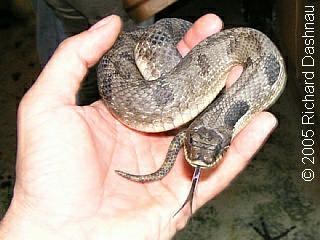 -
-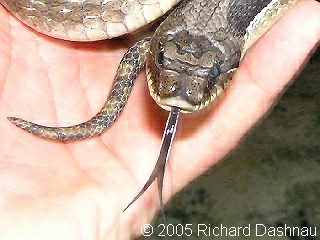 -
-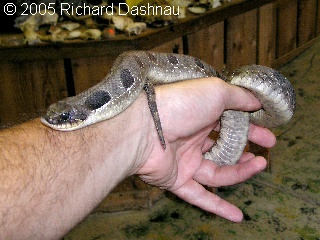
BIGGER
HANDFUL
FORKED TONGUE
IT LIKES MY WARM PULSE
-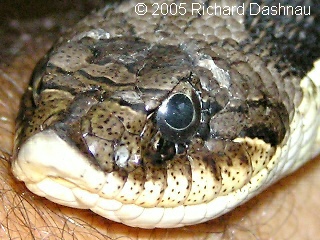 -
-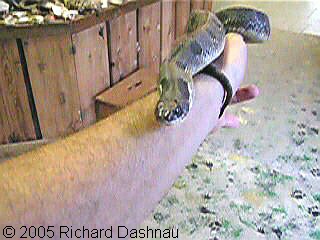
THE NOSE PLOW
VIDEO
CLIP(336KB)
October
03, 2004Today's
RICKUBISCAM shows water snake that leisurely crossed the trail. I think
this is a Green Water Snake (see TRAIL CROSSING, below). -----------------------------------------------------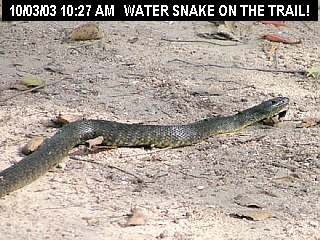
TRAIL CROSSING
I was
able to crop a closeup of the head (GREEN WATER SNAKE, below). Some time
later, I watched at one of the small ponds as 3 to 5 water snakes foraged.
They appeared to be Broadbanded
Water Snakes.
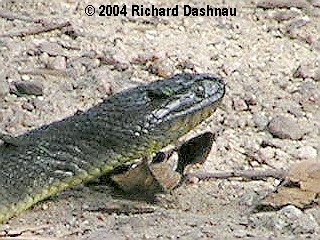 -
-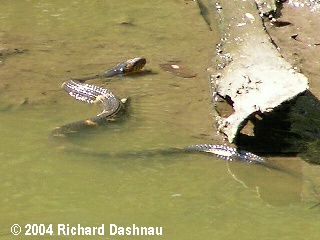 -
-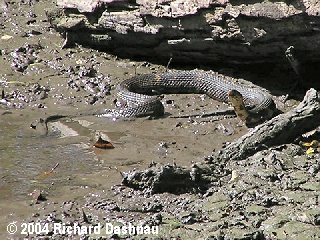
GREEN
WATER SNAKE
BROADBANDED HUNTING
JUST
ATE A
FROG
-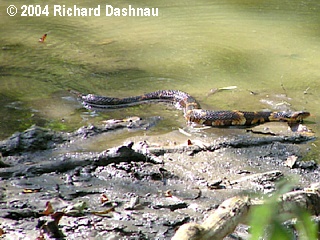 -
-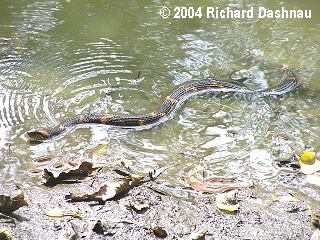
ANOTHER ONE
AND ANOTHER ONE
The
snakes weren't obvious at first, because they were foraging underwater.
From time to time, though, there was turbulance as the small fish would
flee, and then sometimes a snake would appear! I watched
one move to the
bank (see BROADBANDED HUNTING, above); and then rested near a log. As I
turned to watch another snake, the first disappeared. But, it reappeared,
chasing a small frog hopping towards
the water. It missed that one, and
continued into the water. It came back out, chasing more frogs, and caught
one. It stopped and rested while it swallowed the frog (see JUST ATE A
FROG, above). I watched
as more snakes appeared (see ANOTHER ONE, and AND
ANOTHER ONE, above). I was able to slowly move closer, and took a few more
pictures of this last one (see WAITING FOR PREY, and BEAUTIFUL
FACE, below).
I believe the Broadbanded Water Snake is one of the prettiest snakes we
have. That orange coloration and large dark blotches make it easy to identify.
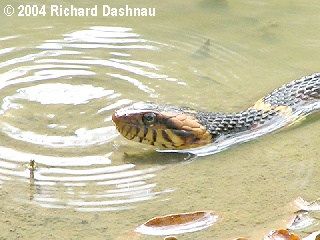 -
-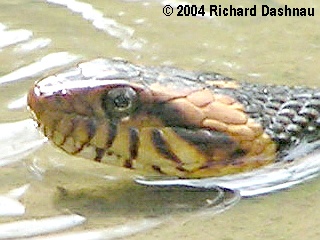 -
-
WAITING FOR PREY
BEAUTIFUL FACE
On May
17, 2004, I'd taken a day off and had gone
to BBSP. The Brazos River was possibly going to flood, due to heavy rainfall
north and west. As I was at the park, water from Big Creek and the Brazos
River
was already starting to backflow
into
the park. As a result of this, and the rain we'd already gotten, many of
the small "islands" that the alligators had been basking on were under
water. So, alligators and other
animals were actively crossing the trails.
------------------
-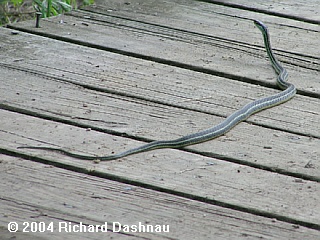 --------------
--------------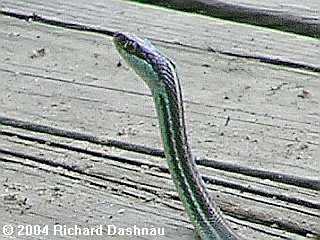
RIBBON SNAKE ON THE BRIDGE
THE RIBBON SNAKE'S HEAD
When
I got to the Spillway Bridge, I saw this good-sized Ribbon Snake (see RIBBON
ON THE BRIDGE, and SNAKE'S HEAD, above). Because of the exposure, and the
distance away, I can't tell exactly which
Ribbon Snake it is, though. I
tried getting a little closer, but it vanished between two bridge planks.
Snakes page 1 nonvenomous 2001 -2002 Snakes page 6 Rat Snakes 2002 - 2021
Snakes page 2 nonvenomous 2003 -2004 Snakes page 7 venomous 2002 -2021
Snakes page 4 nonvenomous 2006 -2021
Snakes page 5 nonvenomous 2022 -2023
Go back to my home page, Welcome
to rickubis.com
Go
back to the RICKUBISCAM page.



























